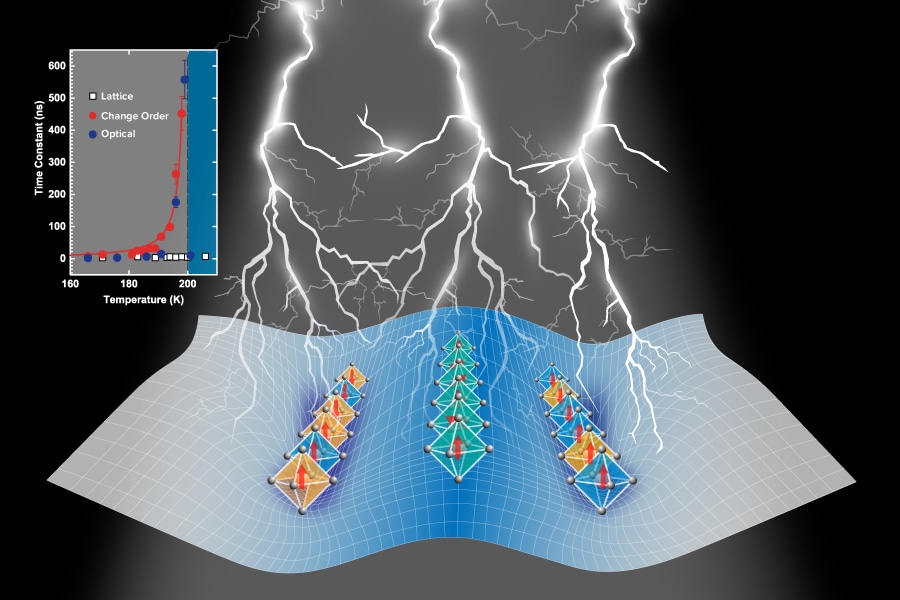Jul 9 2018
As part of an innovative research, scientists from the U.S. Department of Energy’s (DOE) Argonne National Laboratory have ascertained that in certain oxides, electrons can undergo an “unconventional slowing down” of their response to a light pulse.
 Electrons in some oxides can experience an “unconventional slowing down” of their response to a light pulse, according to Argonne material scientists and their collaborators. This surprising behavior may result in useful properties related to magnetism, conductivity, or even superconductivity. (Image credit: Argonne National Laboratory)
Electrons in some oxides can experience an “unconventional slowing down” of their response to a light pulse, according to Argonne material scientists and their collaborators. This surprising behavior may result in useful properties related to magnetism, conductivity, or even superconductivity. (Image credit: Argonne National Laboratory)
The scientists reported that the behavior lasted about one-millionth of 1 second, which is still a million times slower when compared to conventional electronic recovery times.
It’s as if the electron is spending two years or more dithering between states when normally it could make up its mind in a minute.
Anand Bhattacharya, an Argonne materials scientist and co-author of the study,.
The study was published in the Nature Communications journal on May 4th 2018.
All the atoms inside a crystal form a periodic structure known as a lattice, in which the atoms are arranged in a recurrent pattern in three dimensions. The characteristics of the electrons occupied in this space essentially follow the same periodicity.
However, below a temperature of around –100 °F the electrons in lanthanum strontium ferrite, the material under study, find it more energetically beneficial to work together with the lattice and magnetism on the iron atoms, to form a new periodic structure known as a magnetically driven, charge-ordered state.
The behavior arises very near to a temperature that signifies a phase transition—analogous to the way in which 32 °F signifies the transition of phase from water to ice. However, the phase transition analyzed here is unique since it signifies a transition from a magnetic insulator to a non-magnetic metal. Bhattacharya stated that these types of phase transitions are prospectively helpful as “switches,” where the “on” and “off” states of a material could enable toggling between magnets, metals, superconductors, and insulators.
Yet, the material under study—i.e., La1/3Sr2/3FeO3—had something unique in it.
We’ve discovered that electrons can be very slow to return to their homes after being kicked out from the ‘ordered states,’ taking much longer than we previously anticipated.
Haidan Wen, Argonne physicist and co-author of the study.
Since the mass of the electrons is lesser than that of the atoms in the lattice, they often react more rapidly to the light pulse, settling into their new state even before the lattice comes to rest. However, in this case, the recovery of electrons lasts considerably longer compared to the lattice recovery, as ascertained by means of experiments performed at the Advanced Photon Source’s (APS) beamline 7ID-C and at the Center for Nanoscale Materials (CNM), both DOE Office of Science User Facilities.
The scientists performed transient optical reflectivity measurements at CNM with Argonne researcher Richard Schaller, and found that when the temperature reached the phase transition the relaxation of electrons slowed down by several orders of magnitude. Complementary hard X-ray diffraction at the APS was used to measure structural variations, in order to ascertain the rate at which the lattice and charge-ordered phase evolved.
The authors of the study stated that the abnormal behavior of electrons is probably an outcome of magnetic interactions. Traditionally, both the regions on either side of a first-order phase transition are largely different, like water and ice. Yet, Hyowon Park, an Argonne theorist who holds a joint appointment with the University of Illinois at Chicago, observed that magnetic interactions very near to the phase transition actually led to the occurrence of two distinctive types of charge-ordered states.
When the excited electrons attempt to return back to the charge-ordered phase, they encounter a very shallow downhill slope into one of the two charge-ordered states, which eventually slows down the ordering processes. Additional experimental study would be required to obtain microscopic-level knowledge on the precise way in which the electrons spatially organize themselves between the two charge-ordered states.
For Bhattacharya and Wen, gaining insights into these “slow” processes in the domain of ultrafast phenomena may provide innovative ways to increase or stabilize the lifetime of exotic transient states that arise when a material is struck with a light pulse. Such an understanding could disclose potentially useful characteristics associated with conductivity, magnetism, or even superconductivity.
The team also used Argonne’s Laboratory Computing Resource Center. Other co-authors of the study are from the University of Illinois at Chicago, Northwestern University, and Dublin City University.
The work, titled “Unconventional slowing down of electronic recovery in photoexcited charge-ordered La1/3Sr2/3FeO3,” was funded by the DOE Office of Science, Basic Energy Sciences, and also the University of Illinois at Chicago.